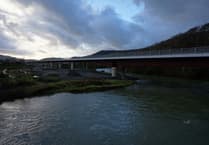The long-awaited Dyfi A487 bridge has finally opened to the public on Friday 2 February, dubbed a “symbol” of future Welsh road projects. The bridge opened with a plaque unveiling by deputy minister for climate change Lee Waters.
Pupils from Ysgol Bro Hyddgen then cycled over the bridge with Mr Waters, becoming the first cyclists to use the new cycle path.
The bridge then opened to public traffic, pedestrians, and cyclists that same afternoon.
Unveiling the plaque along with staff from bridge builder Alun Griffiths Contractors, Powys county and Machynlleth town councillors, Lee Waters said: “This area suffers terribly from flooding. Huge disruptions and detours have become a way of life around here, so this bridge is going to make a real difference in people’s lives.
“It also creates resilience to what is going to be an ever wilder and wetter climate. It’s going to get worse than this, so it’s good that we’ve got the infrastructure now in place to prepare us for that.
“A big thanks to the team who have done all the work here -it’s been a tough job so thank you for your efforts.”
The new single-carriageway complete with pedestrian and cycle paths will relieve the old 19th century bridge 480m downstream, which regularly closed to flooding.
The estimated £46 million project, first proposed in 2018, built the new 1.2km of road across three years, starting in spring 2021 after a one-year delay due to the Covid-19 pandemic affecting the start of construction.
The project is the first to be completed since the Welsh Government committed in February 2023 to only invest in road projects that help reduce carbon emissions, adapt to climate change impact, and provide connections to jobs whilst encouraging public transport options.
The new bridge is said to connect north and south Wales, connecting Machynlleth to Corris across the Afon Dyfi and the wide and often flooded valley.
Mr Waters said: “It has been great to visit today to open this new bridge which is a very visible symbol of the changes we are making, and the way roads will be built from now on.
“This key strategic route links north and south Wales and provides connectivity to healthcare, education, employment, and leisure.
“I was particularly pleased to be among the first group of people on bikes to take advantage of the new cycling and walking route that is fully integrated into the new bridge, as part of a wider active travel network being developed in and around Machynlleth.
“This shows how we can make it easier to walk and cycle in rural Wales, as well as in our more urban towns and cities.”
David Parr, managing director of Griffiths added: “We are proud to see the Dyfi Bridge Scheme open to the public.
“The scheme has been a real technical challenge but is testament to our commitment to addressing the effects of climate change, enhancing community access to essential healthcare and education services, all whilst focusing on active travel solutions.
“Through collective efforts, we have not only reduced our carbon footprint from construction but also invested in future generations through nurturing talents through apprenticeships.”
Mr Waters said that despite the announcement that there would be new restrictions on new road developments, this would not be the last large-scale construction in Wales. He added: “We’ll keep building roads but only ones that have a clear purpose.
“You can’t build your way out of congestion- we’ve been trying that for 50 years and it’s failed. When we build roads, they will now have to pass our four tests.
“One of the tests is resilience to the changing climate, with increased storms and flooding we’re going to see. That’s why this new bridge ticks the box.
“We will continue to build roads but when we build roads, we want to build alternatives too, rather than simply constantly trying to play catch up with growing levels of traffic.”
The proposal for the development was to make crossing the Afon Dyfi easier and safer, as the 200-year-old stone bridge, which was the only vehicle crossing point in the area, was regularly damaged due to the volume of traffic crossing the north/south Wales divide at the popular A-road junction.
The route would often flood in winter months as the river level rose, stopping those north and south of the bridge from having a way of crossing without significant diversion.
The new bridge construction also aimed to “make it easier to access jobs, healthcare, education... [and] to make it easier for people to walk, cycle and wheel across the bridge.”
Flood bunds were installed to protect Dyfi Eco Park south of the bridge and the road under the railway leading to nearby Machynlleth station, whilst emergency surface water pumping facilities were also installed to limit flood water under the railway and by the Dyfi Cottages north of the old bridge.
The old bridge has now closed to begin the flood reinforcement works north of the bridge on the A493, linking to the new A487 bridge.
A stretch of road north of the old bridge will be closed from 10 February for approximately 30 days to reinforce flood defences and improve drainage to the Dyfi Cottages which sit on the north side of the A493 opposite the bridge.
Machynlleth mayor Jeremy Paige said on the development: “My champagne is on ice until the road to Pennal [the A493] is opened and works are completed.
“It will be hugely significant in terms of access to hospitals from north of the bridge along with getting to work and schools. It will also protect the old bridge which is regularly damaged.
“It is pleasing to see the listed cottages being looked after. I would like to extend thanks to Griffiths for their work on this difficult project.”
Meanwhile, landscaping work in and around the construction zone continues including tree planting, as well as returning the land under the viaduct to green fields.


.png?width=209&height=140&crop=209:145,smart&quality=75)



